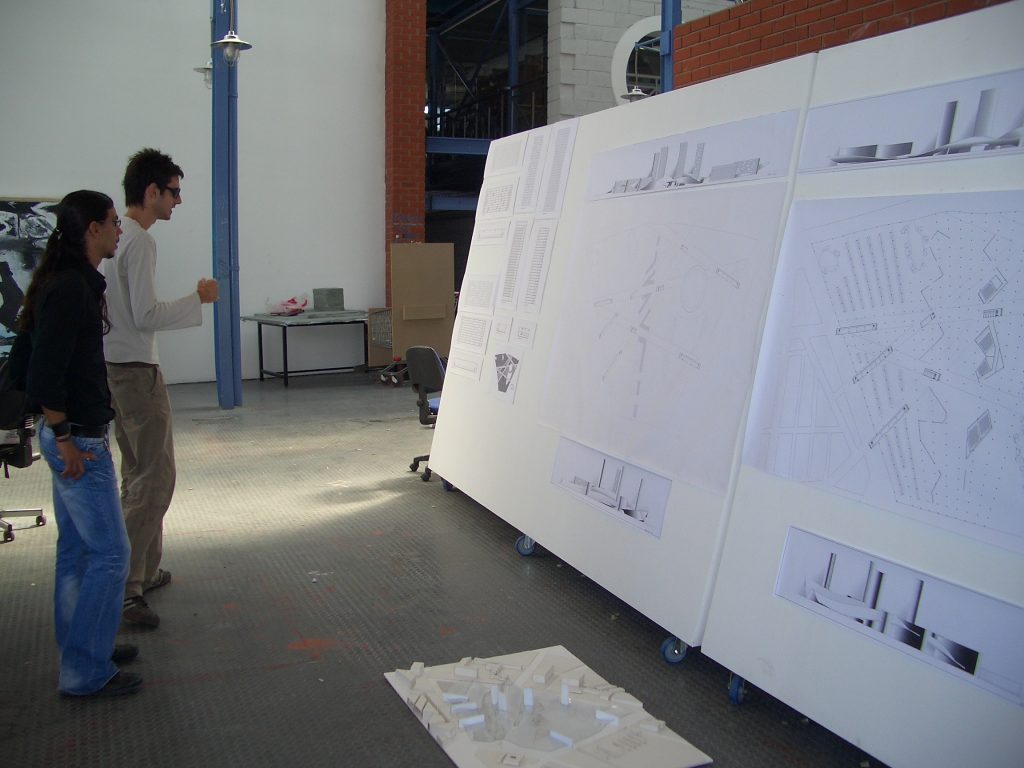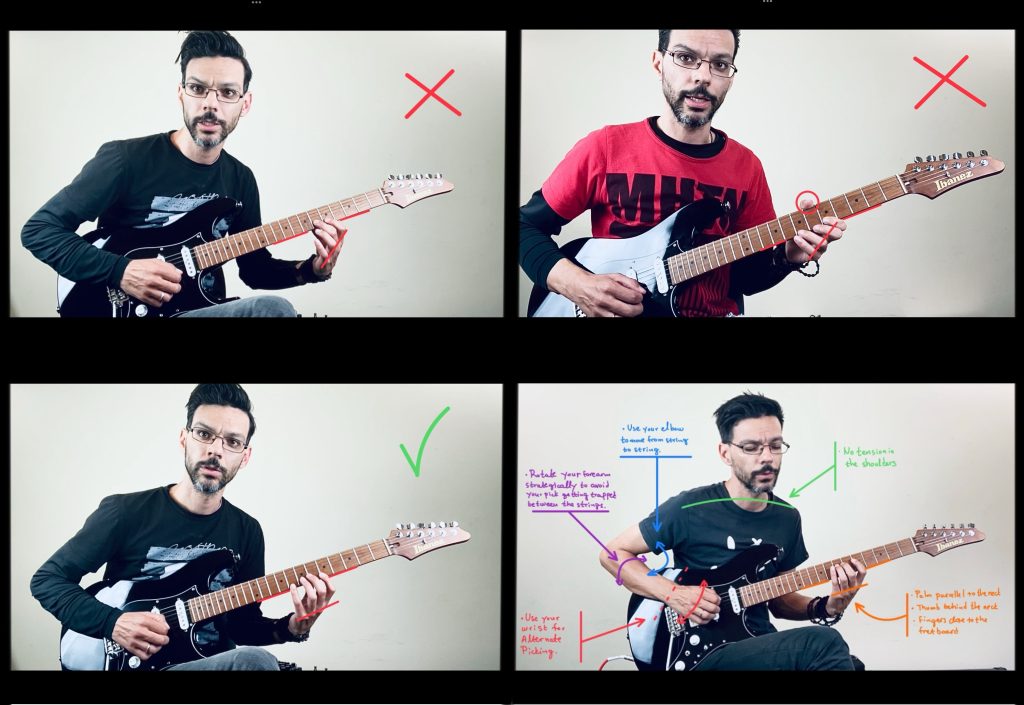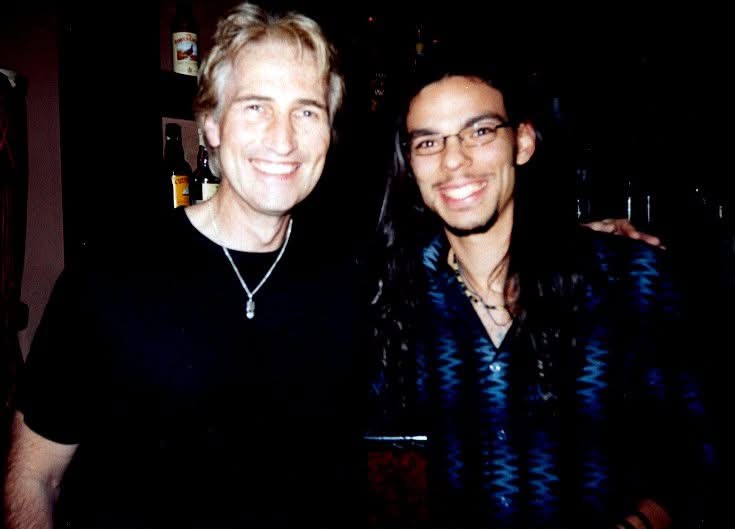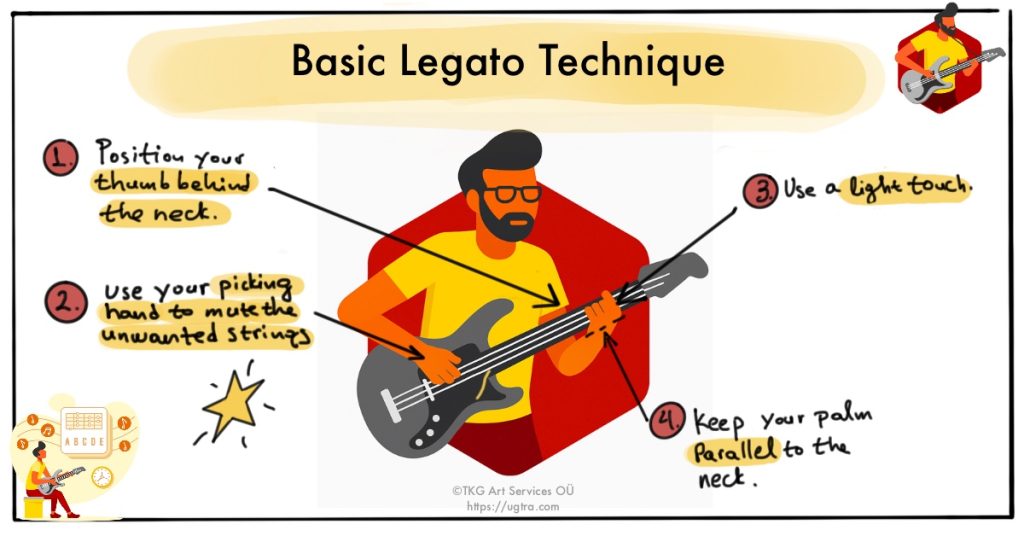[This piece comes from my Guitar Technique Booster Course. It’s focused on the legato guitar playing and has been lightly adapted for this article.]
When I was preparing for my entrance exams to study architecture, one of the biggest challenges I faced was pencil drawing. The task was to observe a composition of two or three 3D objects and recreate it on paper as realistically as possible. But how do you translate three-dimensional objects onto a flat, two-dimensional surface? The answer lies in the art of illusion—using perspective and shading to trick the eye into perceiving depth where none exists.
This concept of illusion is just as relevant in guitar playing, especially when it comes to legato. Unlike the piano, where overlapping notes create true legato, the guitar doesn’t naturally allow for that. Instead, we create the illusion of legato, making the notes flow seamlessly. And that’s exactly what we’ll break down in this article—how to build that illusion on the guitar, step by step!


What Is Legato?
Legato, derived from the Italian word for “tied together,” is a technique where notes are played as smoothly and connectedly as possible. On the guitar, it’s the smoothest timbre we can produce, often contrasting with the fully articulated sound of alternate picking. In sheet music, legato is indicated by a curved line above or below the passage.
Think of legato as the opposite of alternate picking. While alternate picking relies on the right hand to articulate each note, legato shifts much of the responsibility to the fretting hand. This shift not only changes the sound but also opens up new possibilities for musical expression.
Basic Fretting Hand Technique
Advanced legato techniques require a strong foundation—let’s start by focusing on the basics of the fretting hand:
- Thumb Placement: Keep your thumb behind the guitar neck, roughly opposite the middle finger. This provides stability and allows for better finger mobility.
- Palm Position: Your left hand’s palm should remain parallel to the bottom edge of the neck, avoiding unnecessary tension.
- Finger Proximity: Keep your fingers close to the fretboard, minimizing wasted motion.


These fundamentals are the bedrock of clean, efficient legato playing. For a deeper dive, check out the following guide 👉 Basic Fretting Hand Guitar Technique: Building a Solid Foundation for Speed and Precision
Hammer-Ons from Nowhere vs. Continuous Slurs
Hammer-Ons from Nowhere
This technique involves fretting a note without first picking the string or pulling off from a higher note. Essentially, you “slam” a finger onto a silent string to create a note.
- Motion Mechanics: The fretting finger must deliver all the energy to set the string vibrating.
- Challenges: This requires more force and precision, especially on acoustic guitars where amplification is limited.
- Sound: Creates an ultra-smooth, horn-like tone reminiscent of Allan Holdsworth’s playing.
Continuous Slurs
This involves connecting notes by hammering on and pulling off in sequence.
- Ascending Slurs: Each finger comes down while the prior note remains fretted, minimizing the gap between the two.
- Descending Slurs: A pull-off is executed while another finger presses a lower note, creating continuity.
This technique is a staple of rock legato, as popularized by players like Joe Satriani and Steve Vai. It’s slightly more percussive than hammer-ons from nowhere, adding attack and energy to the sound.
The Role of the Picking Hand
While legato playing minimizes the role of the picking hand, it’s far from irrelevant—and the reason is muting.
Pick Positioning: When picking the first note of a legato passage, use an upstroke and position the pick strategically. Place it under the string above the one you’re playing, while your thumb rests on the remaining strings. For example, if you’re playing on the B string, position the pick under the G string and rest your thumb on the E, A, and D strings. This technique helps mute the strings above the one you’re playing, preventing unwanted noise.
Right Hand Fingers: Use the fingers of your picking hand to mute any string noise from the strings below the one you’re playing. In the previous example, this would mean muting the high E string.
By combining these muting techniques, your legato passages will remain clean, articulate, and free of extraneous noise, allowing the smooth, connected notes to shine through.
Read more about the basic picking hand technique here 👉 Before Practicing Exercises: The Fundamental Picking-Hand Mechanics of Alternate Picking


Tone, Dynamics, and Consistency
One of the biggest challenges in legato playing is ensuring that the notes sound as strong and consistent as picked notes. Focus on:
- Equal Volume: Balance the dynamics between hammer-ons and/or pull-offs so that every note rings out with equal strength and clarity.
- Finger Strength: Develop the strength and precision of your fretting hand using specifically designed exercises to maintain a consistent tone. Clean, precise movements are more important than raw power.
- Practice with Overdrive or Distortion: Practicing with an overdriven or distorted tone can reveal subtle variations in dynamics and expose unwanted string noise. This makes it easier to identify and correct inconsistencies in your technique.
Common Mistakes and How to Avoid Them
- Lifting Fingers Too Far: Keep your fingers close to the fretboard to minimize wasted motion. The problem worsens if you press too hard with the fretting hand’s thumb below the guitar neck or if your palm is positioned at an angle to the bottom edge of the neck. Maintaining a relaxed and aligned hand position is key to efficient movement.
- Poor Muting: Use your picking hand to mute strings and eliminate unwanted noise. Be sure to utilize both the pick and your fingers for effective muting.
- Rushing: Build clarity before speed. Remember, the illusion of legato breaks down at slow tempos if gaps between notes become audible. Practice at slow tempo first and gradually increase the BPMs.
Inspiration from the Masters
Great guitar players like Allan Holdsworth, Brett Garsed, Tom Quayle, and TJ Helmerich have redefined what’s possible on the instrument, each bringing a unique approach to technique and expression.
- Allan Holdsworth: Known as a pioneer of jazz fusion and progressive rock, Holdsworth’s groundbreaking legato technique and complex harmonic vocabulary have inspired generations of guitarists. His ability to create smooth, saxophone-like phrasing on the guitar, combined with his use of unconventional scales and chord voicings, set him apart as one of the most innovative players in history. Holdsworth’s dedication to pushing the boundaries of the instrument serves as a powerful reminder that true mastery lies in exploring uncharted musical territories.
- Brett Garsed: Renowned for his fluid legato playing and hybrid picking technique, Garsed’s playing is a masterclass in combining technical precision with melodic expression. His improvisational approach, which focuses on designing the phrases than rigid scale patterns, allows him to craft lines that feel organic and deeply musical. Garsed’s ability to seamlessly blend wide intervals, chromatic tones, and slide guitar techniques makes his style both distinctive and inspiring. [I had some lessons with him years ago, I may write an article of an interesting string skipping concept he shared with me]
- Tom Quayle: A modern virtuoso, Quayle has taken legato playing to new heights, emphasizing efficiency of motion and fingertip accuracy. His approach to improvisation, rooted in jazz fusion, is characterized by smooth phrasing, advanced harmony, and a deep understanding of the fretboard (notably, he tunes the guitar EADGCF). Quayle’s focus on economy of motion and his innovative use of hybrid picking make him a standout figure in contemporary guitar playing.
- TJ Helmerich: A pioneer of eight-finger tapping and a master of studio production, Helmerich’s playing is as technically impressive as it is musically engaging. His ability to combine intricate tapping lines with melodic phrasing and dynamic control showcases his deep understanding of the instrument. Helmerich’s work, both as a solo artist and in collaboration with Brett Garsed, highlights the power of innovation and collaboration in pushing the boundaries of guitar technique.
These masters remind us that technique is not an end in itself but a tool for unlocking creativity and expression. By studying their approaches, we can learn to push our own playing to new levels while staying true to our unique musical voice.
With Brett Garsed years ago!😎🎸🎶👉


FAQ
Why do notes fade away when playing legato?
Notes often fade away during legato passages due to insufficient finger strength, energy, or accuracy when executing hammer-ons and pull-offs. To address this, focus on building the strength and precision of your fretting hand through targeted exercises. Consistent practice will ensure each note rings out clearly and with equal intensity.
Can I develop legato technique on an acoustic guitar?
Yes, you can develop legato technique on an acoustic guitar, but it’s more challenging due to the lack of amplification. The notes require more finger strength and precision to sound clear. If possible, start practicing on an electric guitar, as it provides more sustain and makes it easier to hear the nuances of your technique.
Should I always pick the first note of every string?
Not necessarily. It depends on the musical context and the tone you want to achieve. Picking the first note can add clarity and attack, while skipping the pick entirely can create a smoother, more fluid sound. Let the music guide your choice.
Final Thoughts
Legato is an incredible expressive tool for crafting smooth, flowing timbre that adds a unique color to your playing. Don’t get caught up in chasing “perfect” legato or debating which technique—hammer-ons from nowhere or slurs—is superior (I use both). Instead, focus on using legato to captivate your listener through genuine musical expression.
Remember, the goal isn’t just to play notes. It’s to tell a story. Legato gives you the power to expand the emotional and tonal palette of that story, making your music more vivid, dynamic, and compelling.
